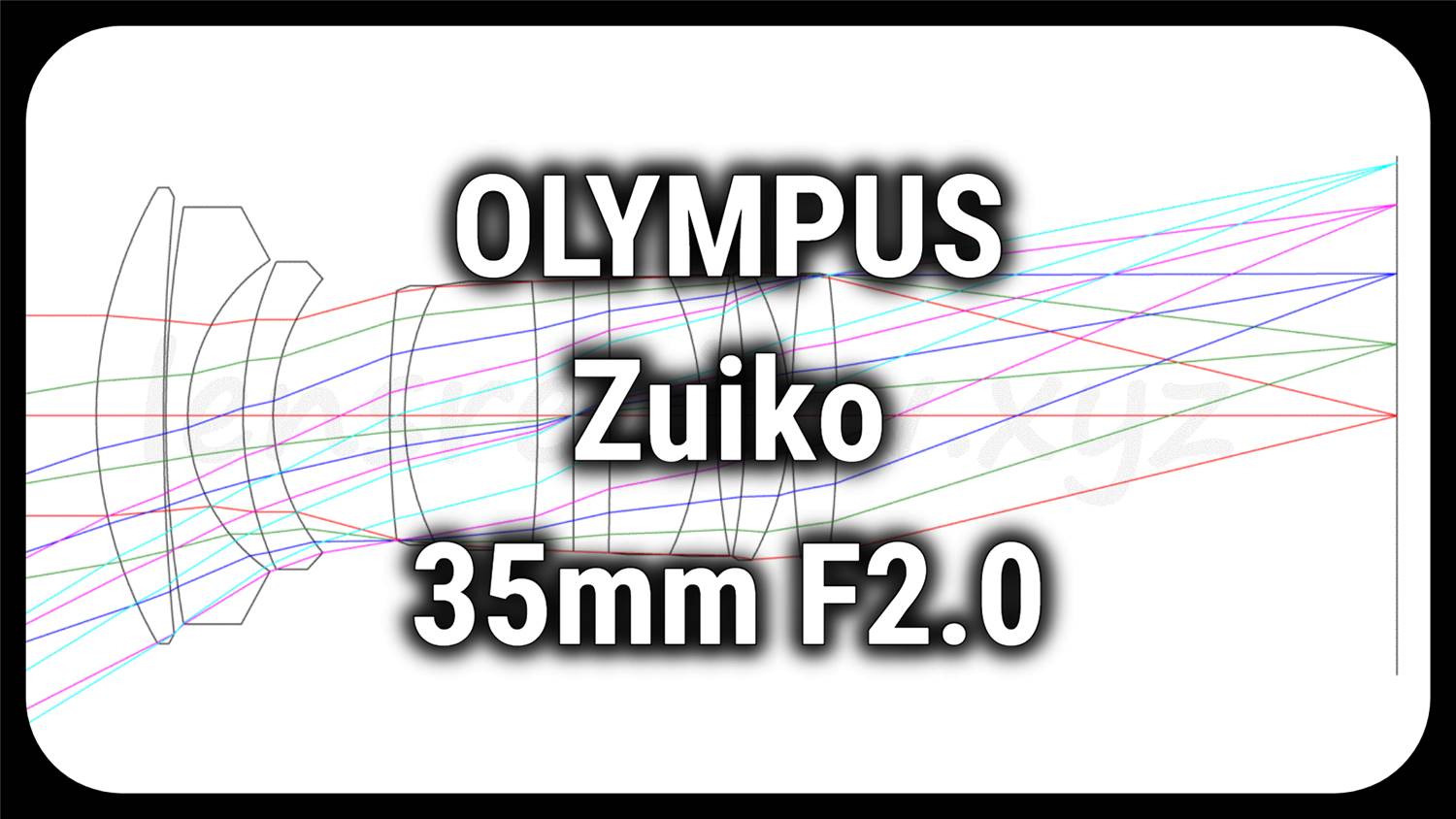Olympus Zuiko 35 F2.0 performance analysis and review article.
We analyze the lens performance through simulation by inferring the design values of the optical system from patent information and actual photographic examples.
Professional lens designer Hitoshi Takayama carefully unravels design information such as optical path diagrams and aberration characteristics, which are rarely seen by the general public, and explains them in depth and gently.
Please enjoy the special information that can only be read on this blog.
If you are looking for example photos, you can find them at the end of this article.
The original site has more articles.
https://lensreview.xyz/
Overview
This Zuiko lens for the Olympus OM mount from the film era is a large-aperture lens on the wide-angle side.
While Zuiko's small aperture lenses are highly acclaimed, the large apertures, including this lens, are regarded as peculiar and peculiar.
In general, lenses with a focal length of 50 mm have a large aperture, a bright f-no, and a low price, as well as a small size.
On the other hand, 35mm focal length lenses are next to 50mm lenses, so people have preconceived notions and expectations that they must be very good, and this may be the fate of 35mm lenses.
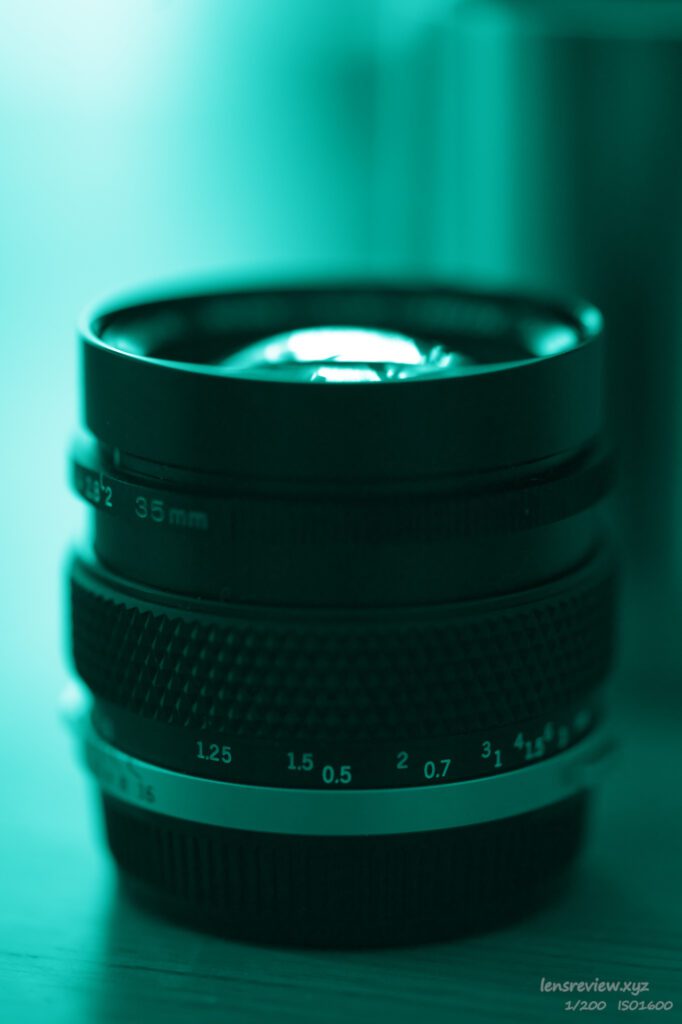
Private Memoirs
I made my full-fledged debut as a camera wannabe when I picked up an OM-1 and a 35mm f/2.8 in the 1990s.
I had owned SLR cameras long before I started using OLYMPUS' OM series, and I liked the cameras themselves, so when I found the OM, I should say that I "transformed into a resident of the lens swamp".
I could buy a good used Zuiko 35 F2.0 for about 5,000 yen for an F2.8 lens in the 90's. I did not have the money to buy an expensive F2.0 lens, so I did not purchase it until the 2000's. I was not able to buy a Zuiko 35 F2.0 lens until I was in the 80's.
However, to be honest, I had been using the 50mm Fno1.2 and was not able to use it at all at the time of purchase…
Document Survey
When I read through the patent documents to investigate the Zuiko 35mm F2.0, I found that some of the configurations are very similar, if not exactly the same as the cross-sectional drawing of the product.
The possible reasons for this discrepancy are imagined to be that the design values were further refined after the patent application was filed, or that the design values had to be changed for some reason during development.
Note: This is just my imagination.
I have heard an urban legend that "some manufacturers' lens construction drawings in their catalogs are rather crude"…
Since there is no significant difference in the number of lens elements and shape, we assume that Example 1 of JP-A-40127 is similar to the product configuration and try to reproduce it.
Notes!
The following design values have been selected and reproduced from the appropriate patent literature and do not correspond to the actual product. Naturally, the data is not guaranteed, and I am not responsible for any accidents or damages that may occur by using this data.
Analysis of Design Values
Optical Path Diagram
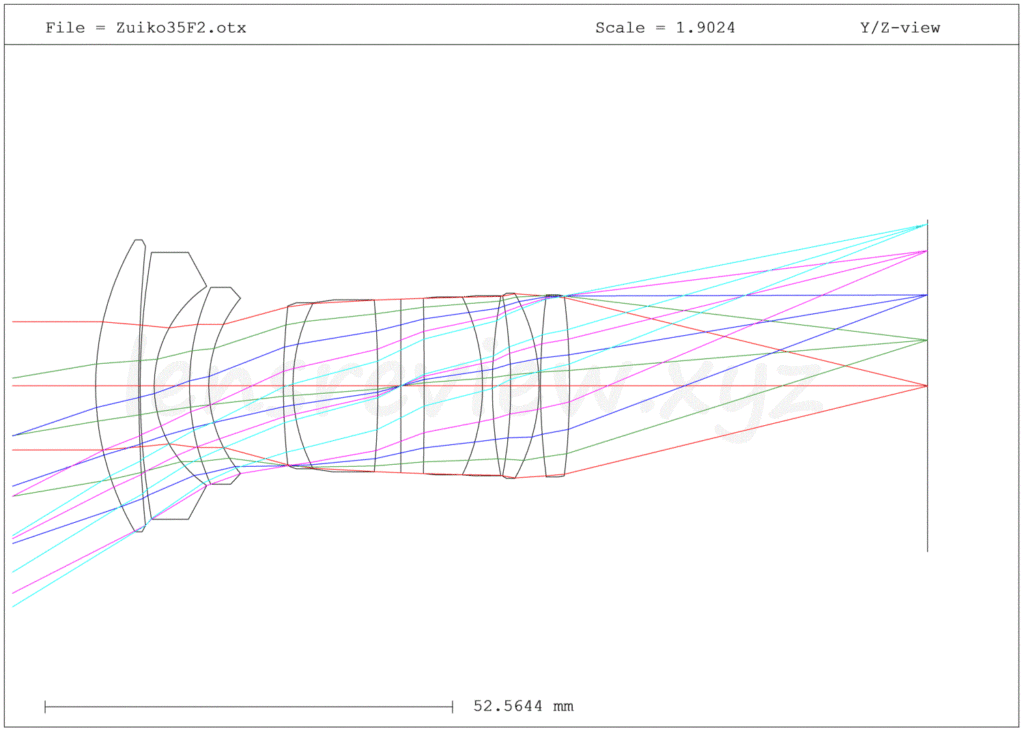
Above is the optical path diagram of the zuiko 35 F2.0.
It consists of 9 elements in 7 groups. The basic construction of a lens for an SLR camera is said to be Gaussian type, but the wide-angle side of the lens shows almost no Gaussian aspect.
The most common type of wide-angle lens configuration for SLR cameras is known as retrofocusing, in which a concave lens is placed on the subject side.
However, the first lens of this Zuiko 35mm F2.0 is a convex lens with extremely high power. Just by looking at the cross-sectional view, you can see the unique world of this lens.
At that time, 35mm lenses were usually f/2.8, and this lens is one step brighter at f/2.0.
In order to reduce the bloat caused by this brightness, a strong convex lens was placed on the subject side to shorten the overall length of the lens.
In particular, the Zuiko lens series for the OM mount is marketed as a "compact camera system," so even a large-aperture lens may have been designed to be compact.
Although the overall number of lenses is large, the aberration correction seems to be suffering, perhaps because of the emphasis on size reduction.
The glass material does not use special low-dispersion materials to suppress the axial chromatic aberration characteristic of large-aperture lenses, so chromatic aberration also seems to be a problem.
Today, we can obtain lenses with perfectly suppressed aberrations, so the more aberrations you have, the more fun you will have, so I am very excited about this lens.
Let's take a look at the aberrations.
Longitudinal Aberration
Spherical Aberration, Field Curvature, Distortion
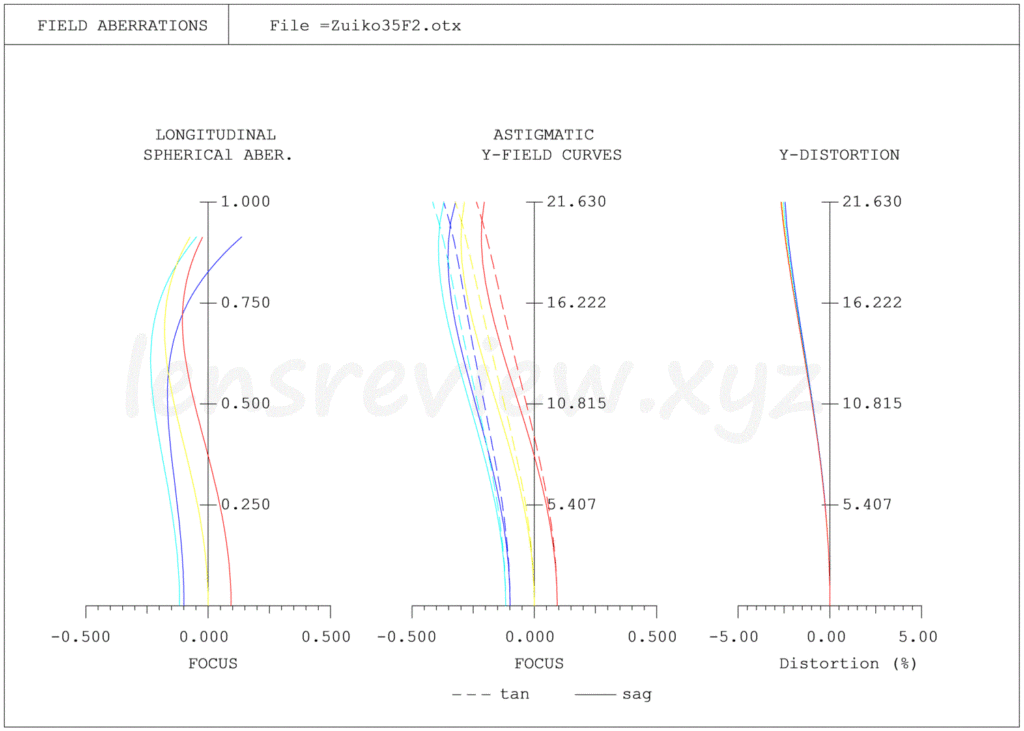
Spherical Aberration , Axial Chromatic Aberration
Even though spherical aberration is corrected to full correction type, its bulge seems to exceed that of the 50mm f/1.2 and fluffy pictures can be expected.
Conversely, you can fully appreciate how easily the 50mm's aberrations are corrected with the benefit of the Gaussian type.
Axial chromatic aberration has a characteristic of decreasing in proportion to focal length, so it should be easier to reduce it in wide-angle lenses, but this lens seems to have more aberration than telephoto lenses.
However, the C-line and F-line coincide at the top of the spherical aberration graph at 10% of the height of the rays, and the rays of each color overlap at about 70% of the height of the rays. The lens seems to be beautifully put together while retaining axial chromatic aberration.
Field Curvature
field curvature is a large undercutting of the image plane to compensate for the lack of correction of spherical aberration. It is a basic technique to bring the entire image into focus by producing aberrations. However, this method generates an aberration component called halo-coma, which is a transverse aberration, so the MTF will be lower overall.
Distortion
Distortion is slightly barrel shaped, but within a small range in absolute value and not particularly problematic
Lateral Chromatic Aberrations
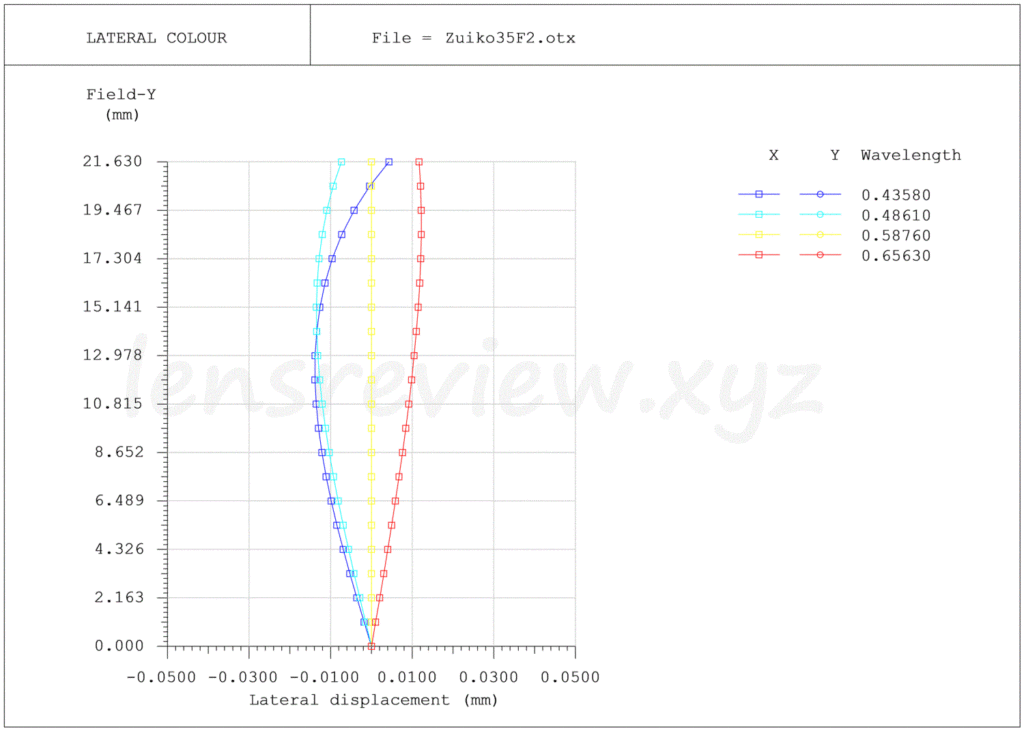
The lateral chromatic aberrations remains quite large. Although it becomes more noticeable when the lens is stopped down, it is already noticeable from wide open.
Transverse Aberrations
(Left)Tangential direction, (Right)Sagittal direction
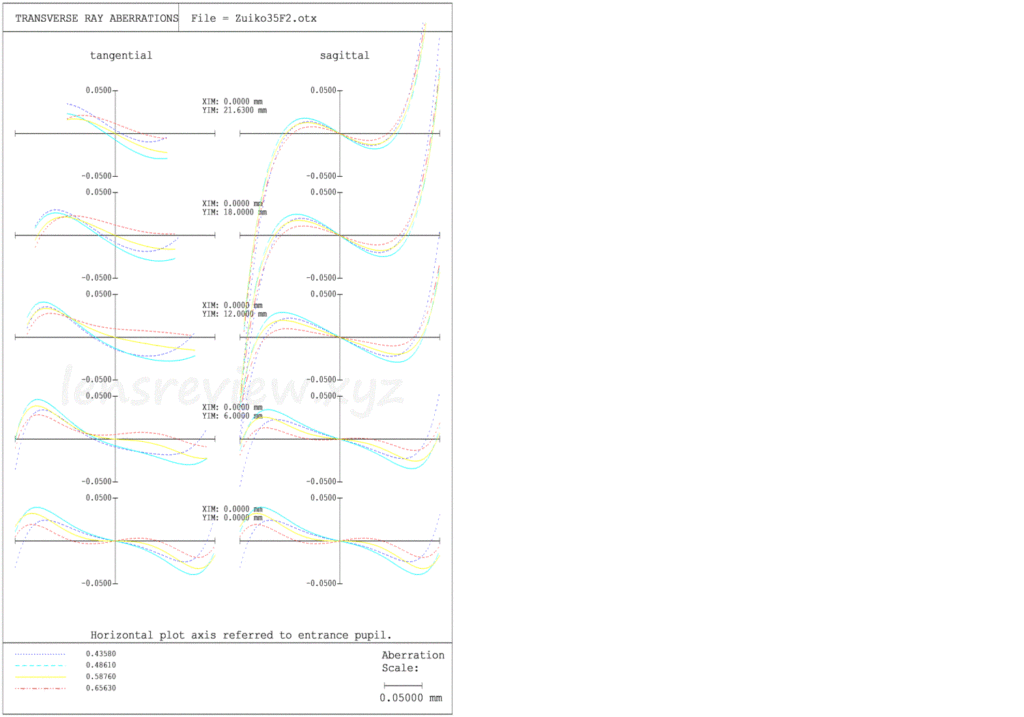
The Zuiko 50mm F1.2 has large sagittal flare and tangential aberration at the level of the Zuiko 50mm F1.2, but the focus balance seems to be maintained by producing halo coma.
Spot Diagram
Spot Scale 0.3 (Standard)

Spot Scale 0.1 (Detail)
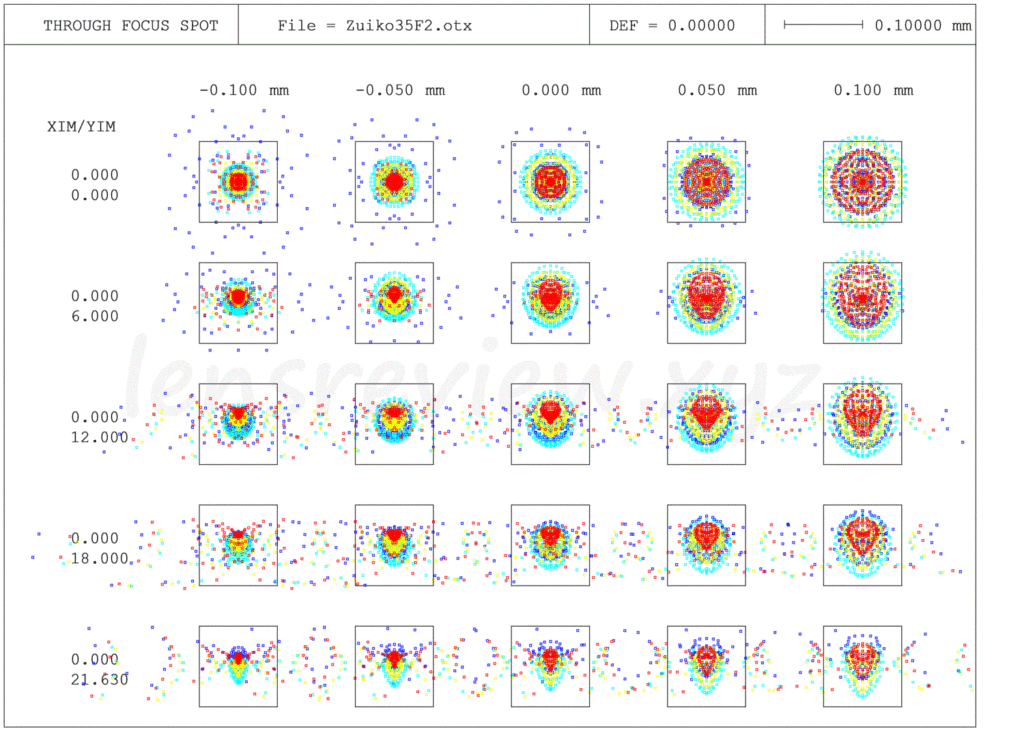
MTF
Maximum Aperture F2.0
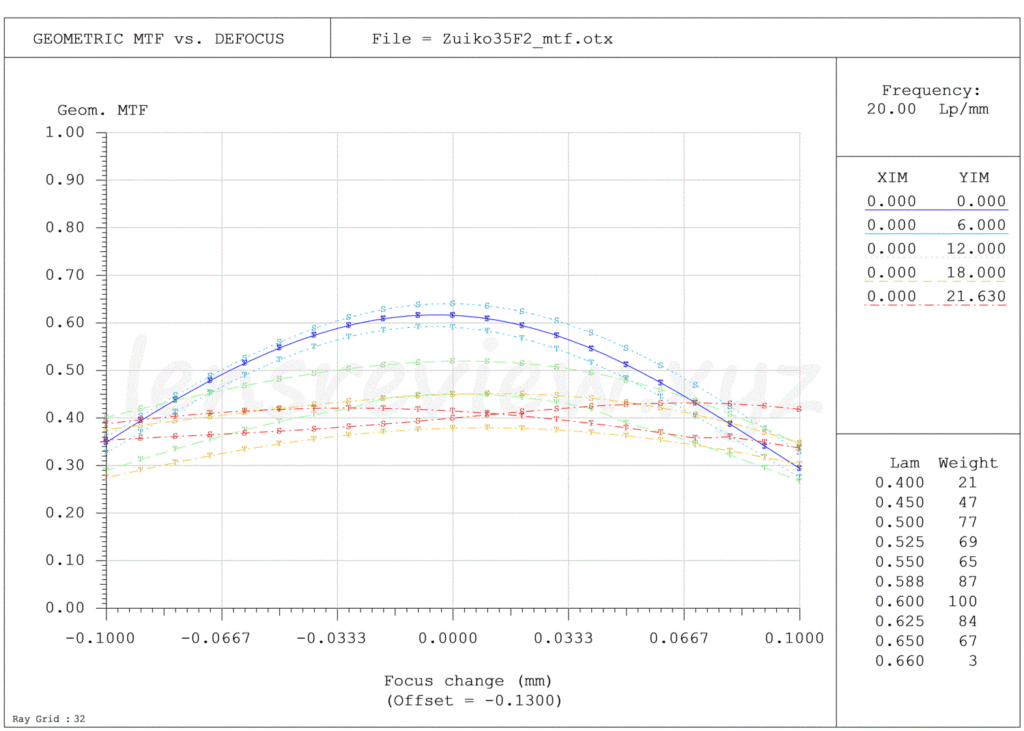
The mountains are high in the center of the screen, but from the middle of the screen to the periphery, the characteristics are quite low. The position of the mountains is consistent across the entire image and there seems to be no discrepancy.
Small Aperture F4.0
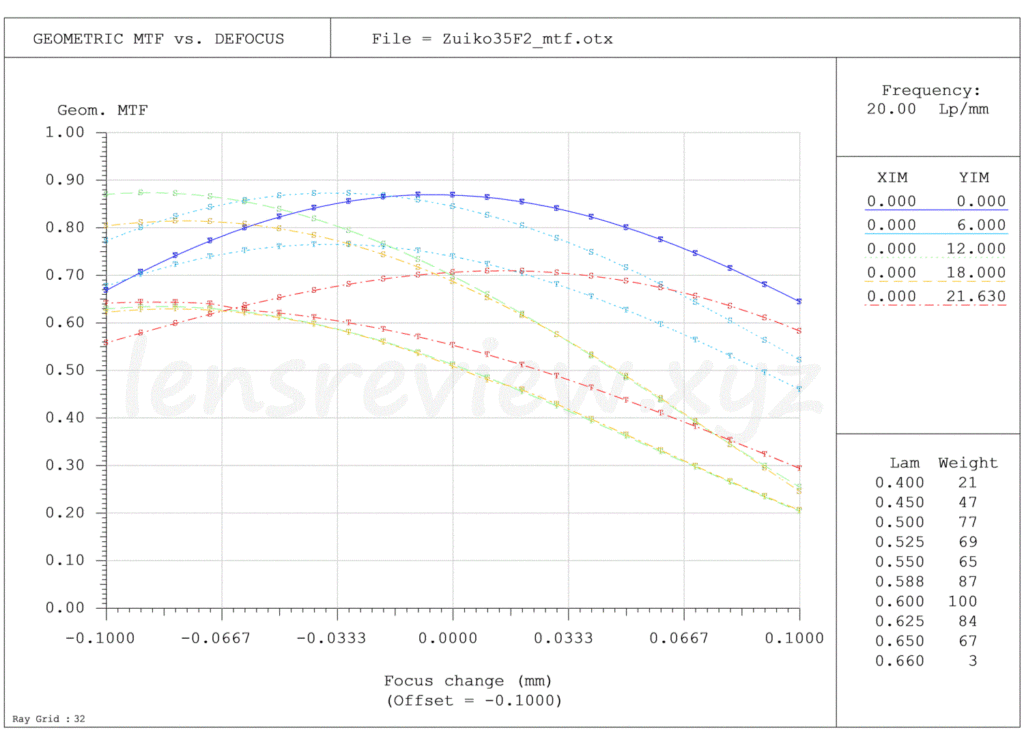
When stopped down, the high MTF value improves to a surprising degree.
Lenses at that time did not emphasize performance at maximum aperture f-no, but were designed to show their true value when stopped down.
In the film era, sensitivity was generally around ISO 400, so a brighter f-no was required to increase shutter speed, and a lower maximum aperture f-no was acceptable.
It was also considered "common sense" to always stop down one stop when taking serious photographs.
Conclusion
It is a quirky ball, just like the rumors on the street. When you take actual photographs, you often find yourself wondering whether the image is resolved, out of focus, or shaky. In particular, the blur in the background has a large aberration that produces a unique blurring effect that makes it difficult to tell where the camera is in focus. However, it is also strange that I sometimes feel like using the Zuiko 35 F2 when I am using only modern high-performance lenses.
This lens is a must-have for those who are looking for a tasteful lens.
The original site has more articles.
https://lensreview.xyz/
Sample Picture
If you are looking for analysis information on other lenses, please refer to the table of contents page here.
